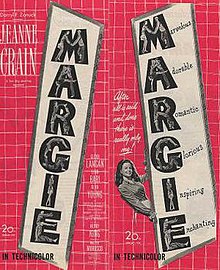
A Letter to Three Wives is a 1949 American romantic drama that tells the story of a woman who sends a letter to three women, saying she has left town with one of their husbands without revealing which one. It stars Jeanne Crain, Linda Darnell, Ann Sothern, Paul Douglas, Kirk Douglas, and Jeffrey Lynn. Thelma Ritter as "Sadie" and Celeste Holm have key supporting roles.

Jeanne Elizabeth Crain was an American actress. She was nominated for an Academy Award for Best Actress for her title role in Pinky (1949). She also starred in the films In the Meantime, Darling (1944), State Fair (1945), Leave Her to Heaven (1945), Centennial Summer (1946), Margie (1946), Apartment for Peggy (1948), A Letter to Three Wives (1949), Cheaper by the Dozen (1950), People Will Talk (1951), Man Without a Star (1955), Gentlemen Marry Brunettes (1955), The Fastest Gun Alive (1956), and The Joker Is Wild (1957).
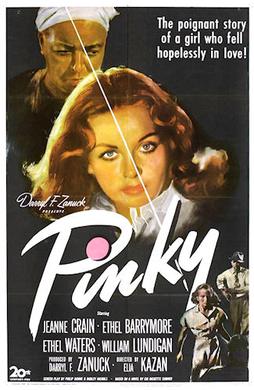
Pinky is a 1949 American drama film directed by Elia Kazan and produced by Darryl F. Zanuck. The screenplay was adapted by Philip Dunne and Dudley Nichols based on Cid Ricketts Sumner's 1946 novel Quality. It stars Jeanne Crain as the title character, a young light-skinned black woman who passes for white. It also stars Ethel Barrymore, Ethel Waters and William Lundigan.
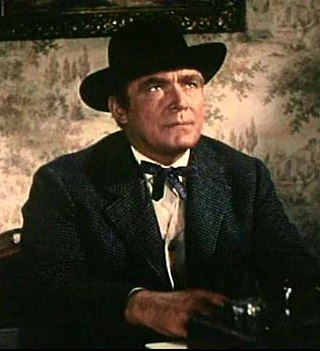
Roy Roberts was an American character actor. Over his more than 40-year career, he appeared in more than nine hundred productions on stage and screen.

Conrad Janis was an American jazz trombonist and actor who starred in film and television during the Golden Age Era in the 1950s and 1960s, and continued acting right up until 2012. He played the role of Mindy McConnell's father Frederick in 53 episodes of Mork & Mindy, and appeared in many guest-starring roles on several notable television shows throughout the 1970s, 1980s, and 1990s such as sitcoms like Maude, The Golden Girls, and Frasier.

Gentlemen Marry Brunettes is a 1955 American Technicolor musical romantic comedy film directed by Richard Sale, who co-wrote the screenplay with Mary Loos, based on the 1927 novel But Gentlemen Marry Brunettes by Anita Loos, aunt of Mary Loos. The film stars Jane Russell and Jeanne Crain. It was produced by Sale and Bob Waterfield, with Robert Bassler as executive producer.

"I'll See You in My Dreams" is a popular song and jazz standard, composed by Isham Jones, with lyrics by Gus Kahn, and published in 1924. It was recorded on December 4 that year, by Isham Jones conducting Ray Miller's Orchestra. Released on Brunswick Records, it charted for 16 weeks during 1925, spending seven weeks at number 1 in the United States. Other popular versions in 1925 were by Marion Harris; Paul Whiteman; Ford & Glenn; and Lewis James; with three of these four reaching the Top 10.
The Fastest Gun Alive is a 1956 American western film directed by Russell Rouse and starring Glenn Ford, Jeanne Crain, and Broderick Crawford. It was produced by Metro-Goldwyn-Mayer.

Hobart Cavanaugh was an American character actor in films and on stage.

This Time for Keeps is a 1947 American romantic musical film directed by Richard Thorpe and starring Esther Williams, Jimmy Durante, Johnnie Johnston and opera singer Lauritz Melchior. Produced by MGM, it is about a soldier, returning home from war, who does not wish to work for his father's opera company or to continue his relationship with his pre-war lover.
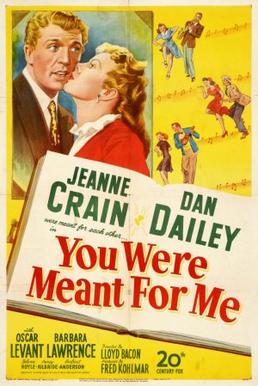
You Were Meant for Me is a 1948 musical film directed by Lloyd Bacon and starring Dan Dailey and Jeanne Crain as a bandleader and his wife. It was released by 20th Century Fox. The film includes performances of "You Were Meant for Me", "I'll Get By ", and "Ain't Misbehavin'".

Joan Elmer Woodbury was an American actress beginning in the 1930s and continuing well into the 1960s.
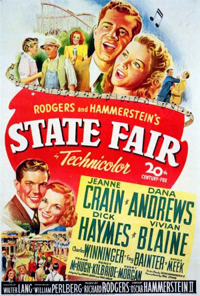
State Fair is a 1945 American Technicolor musical film directed by Walter Lang, with original music by Rodgers and Hammerstein. It is a musical adaptation of the 1933 film of the same name starring Janet Gaynor and Will Rogers. The 1933 film is an adaptation of the 1932 novel by Phil Stong. This 1945 musical film stars Jeanne Crain, Dana Andrews, Dick Haymes, Vivian Blaine, Fay Bainter, and Charles Winninger. State Fair was remade in 1962, starring Pat Boone and Ann-Margret.

Margie is an American television sitcom starring Cynthia Pepper that was broadcast on ABC from October 12, 1961 to August 31, 1962.
Margie is a feminine given name, usually a short form (hypocorism) of the related names Margaret, Marjorie, or Margarita, all of which mean "pearl".

In the Meantime, Darling is a 1944 American drama film produced and directed by Otto Preminger. The screenplay by Arthur Kober and Michael Uris focuses on a wealthy war bride who is forced to adjust to living in spartan conditions in military housing during World War II.
"A Cup of Coffee, a Sandwich and You" is a 1925 song written by Joseph Meyer, with lyrics by Al Dubin and Billy Rose. The title was inspired by the famous line "A Jug of Wine, a Loaf of Bread--and Thou" from the Rubaiyat of Omar Khayyam.

The Well Groomed Bride is a 1946 American romantic comedy film directed by Sidney Lanfield and starring Olivia de Havilland, Ray Milland, and Sonny Tufts. Written by Claude Binyon and Robert Russell, the film is about a man and a woman who fight over the last bottle of champagne left in San Francisco—he wants it to christen a new aircraft carrier, and she wants it as the centerpiece for her upcoming wedding reception. During the course of their fierce battle over the bottle, the two fall in love. This was de Havilland's first film after a two-year legal battle she waged against Warner Bros. regarding her rights under her contract.
Faye Marlowe, also known as Faye Joseph and Faye Heuston was an American film and television actress with a career spanning a single decade, from 1945 to 1955.

Margie Morris was an English stage and silent film actress, revue artist, musician, dancer and singer who worked in the Netherlands during the 1910s and 1920s.
